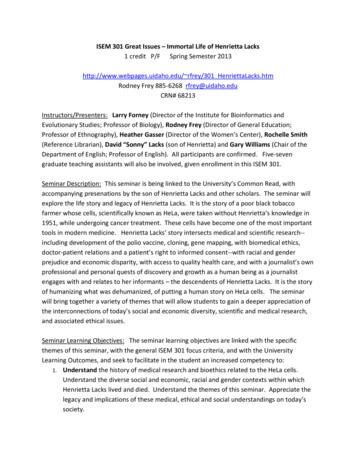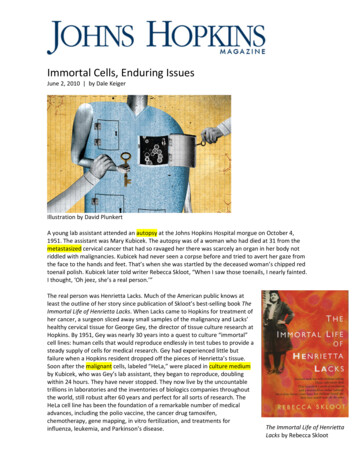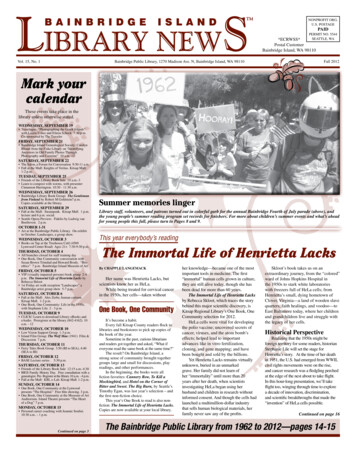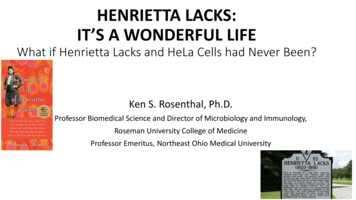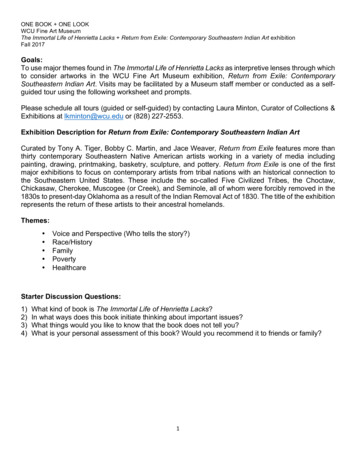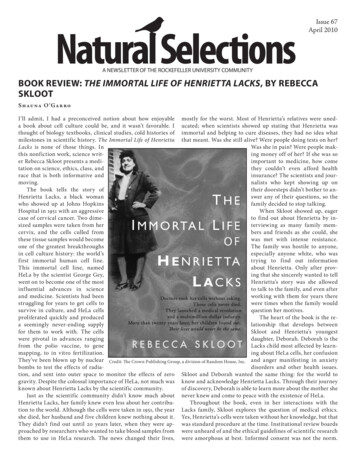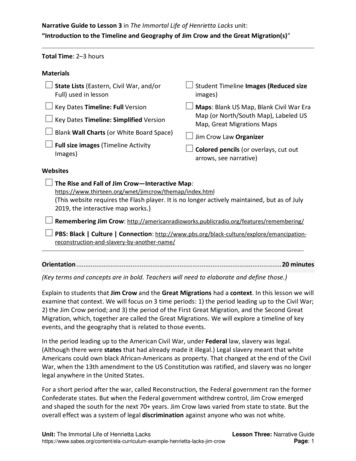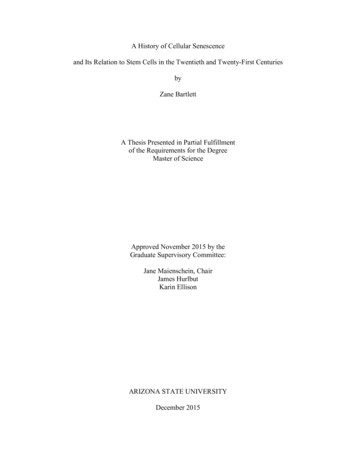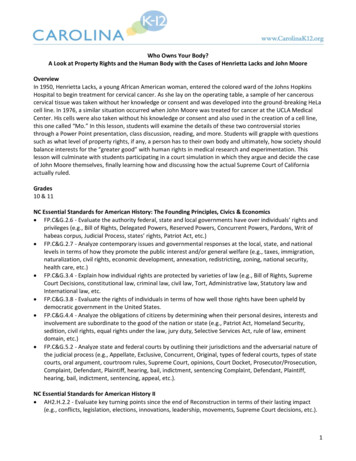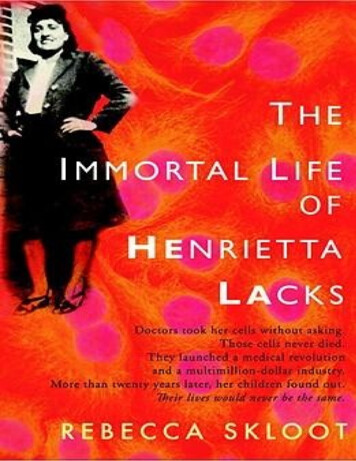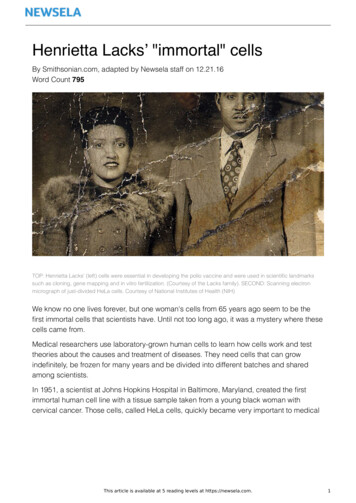
Transcription
Henrietta Lacks’ "immortal" cellsBy Smithsonian.com, adapted by Newsela staff on 12.21.16Word Count 795TOP: Henrietta Lacks' (left) cells were essential in developing the polio vaccine and were used in scientific landmarkssuch as cloning, gene mapping and in vitro fertilization. (Courtesy of the Lacks family). SECOND: Scanning electronmicrograph of just-divided HeLa cells. Courtesy of National Institutes of Health (NIH)We know no one lives forever, but one woman's cells from 65 years ago seem to be thefirst immortal cells that scientists have. Until not too long ago, it was a mystery where thesecells came from.Medical researchers use laboratory-grown human cells to learn how cells work and testtheories about the causes and treatment of diseases. They need cells that can growindefinitely, be frozen for many years and be divided into different batches and sharedamong scientists.In 1951, a scientist at Johns Hopkins Hospital in Baltimore, Maryland, created the firstimmortal human cell line with a tissue sample taken from a young black woman withcervical cancer. Those cells, called HeLa cells, quickly became very important to medicalThis article is available at 5 reading levels at https://newsela.com.1
research. But, no one knew much about the donor. In her book, "The Immortal Life ofHenrietta Lacks," journalist Rebecca Skloot tracked down the story of the source of theamazing HeLa cells.Who Was Henrietta Lacks?Henrietta was a black tobacco farmer from southern Virginia who had cervical cancerwhen she was 30. A doctor at Johns Hopkins Hospital took a piece of her tumor withouttelling her and sent it to scientists who had been trying to grow tissues. No one knows why,but her cells never died.Henrietta’s cells were the first immortal human cells ever grown in culture. Grown in culturemeans cells are taken from their environment, like a human body, to a lab so scientists cangrow more of them to study. This is how scientists can learn more about diseases andsickness. This also helps develop immunizations.Henrietta's cells were essential to developing the polio vaccine. They went up in the firstspace missions to see what would happen to cells in zero gravity. Many scientists haveused her cells for different types of research, including cloning, which is making a copy ofsomething.There has been a lot of confusion over the years about the source of HeLa cells. When thecells were taken, they were given the code name HeLa, for the first two letters in Henriettaand Lacks. But, Henrietta's real name wasn't known until the 1970s.Learning Henrietta's StorySkloot first learned about Henrietta in 1988, years before writing her book. Skloot was 16and in a science class. The teacher knew Henrietta’s real name and that she was black.But that’s all he knew and Skloot wanted to know more. Did Henrietta have any kids? Whatdo they think about part of their mother's cells being alive all these years after she died?Years later, when Skloot was in college, she decided to find Henrietta's family and writeabout them.Skloot was determined to tell Henrietta's story. It took almost a year even to convinceHenrietta’s daughter, Deborah, to talk to Skloot. Skloot went to Clover, Virginia, whereHenrietta was raised. Skloot tracked down Henrietta's cousins, then called Deborah andtold her their stories. This convinced Deborah to help Skloot learn more about Henriettabecause Deborah wanted to know more, too.Deborah never knew her mother; she was an infant when Henrietta died. No one evertalked about Henrietta. So when Deborah found out that this part of her mother was stillalive she became desperate to understand what that meant.This article is available at 5 reading levels at https://newsela.com.2
Finding Out HeLa Is Henrietta LacksTwenty-five years after Henrietta died, a scientist discovered that many cell culturesthought to be from other tissue types, including breast and prostate cells, were in factHeLa cells. It turned out that HeLa cells could float on dust particles in the air and travel onunwashed hands into other cell cultures.So, scientists tracked down Henrietta’s relatives to take some samples from them to usethe family’s DNA to make a map of Henrietta’s genes. This would allow scientists to knowwhich cell cultures were HeLa and which weren’t. It would begin to straighten out thecontamination problem.Lessons From The BookFor scientists, one of the lessons is that there are human beings behind every biologicalsample used in the laboratory. Much of science today revolves around using humanbiological tissue of some kind. The people behind those samples often have their ownthoughts and feelings about what should happen to their tissues, but they’re usually left outof the equation.Skloot hopes people don't think tissue culture is bad because medicine today depends ontissue culture. The need for these cells is going to get greater, not less, Skloot said. Sheadded that scientists just need to look at how this can happen in a way that everyone isOK with.Many tests, basic drugs and all of our vaccines would not exist if it wasn’t for scientistscollecting cells and growing them. Or, if it wasn't for Henrietta.This article is available at 5 reading levels at https://newsela.com.3
Quiz123Which answer choice BEST explains the cause of the confusion about where HeLa cells camefrom?(A)We know no one lives forever, but one woman's cells from 65 years agoseem to be the first immortal cells that scientists have. Until not too long ago,it was a mystery where these cells came from.(B)In 1951, a scientist at Johns Hopkins Hospital in Baltimore, Maryland,created the first immortal human cell line with a tissue sample taken from ayoung black woman with cervical cancer.(C)When the cells were taken, they were given the code name HeLa, for the firsttwo letters in Henrietta and Lacks. But, Henrietta's real name wasn't knownuntil the 1970s.(D)The people behind those samples often have their own thoughts andfeelings about what should happen to their tissues, but they’re usually leftout of the equation.Which section of the article BEST explains that Henrietta Lacks' cells were taken without herpermission?(A)the introduction [paragraphs 1-3](B)"Who Was Henrietta Lacks?"(C)"Learning Henrietta's Story"(D)"Finding Out HeLa Is Henrietta Lacks"How does the article convey the importance of Henrietta Lacks' cells?(A)by quoting excerpts from a book about the life and impact of HenriettaLacks(B)by describing events from the childhood of Henrietta Lacks' daughter(C)by detailing the scientific process of collecting and growing HeLa cells(D)by giving examples of the scientific advances made using HeLa cellsThis article is available at 5 reading levels at https://newsela.com.4
4Which answer choice BEST explains Rebecca Skloot's purpose in writing her book?(A)to share information about the life and family of the woman behind thefamous HeLa cells(B)to bring fame and fortune to the other members of the Lacks family(C)to show the importance of properly labeling cells in a laboratory(D)to give evidence to suggest that scientists should take human cells withoutpermissionThis article is available at 5 reading levels at https://newsela.com.5
Henrietta Lacks’ "immortal" cells TOP: Henrietta Lacks' (left) cells were essential in developing the polio vaccine and were used in scientific landmarks such as cloning, gene mapping and in vitro fertilization. (Courtesy of the Lacks family). SECOND:
